Carbon fiber’s natural color is a deep black. This is not a coating but the intrinsic color of the carbon atoms that form the material. While fundamentally black, its appearance can be altered with different weave patterns (like twill or forged), finishes (matte or gloss), and advanced coloring techniques, such as tinted resins or hybrid weaves.
Carbon Fiber’s Visual DNA
It’s Fundamentally Black: The Science Behind the Color
The first thing to understand is that carbon fiber’s color comes directly from its atomic structure. The material is made of over 90% carbon atoms, and just like other forms of pure carbon like coal or graphite, its inherent color is black. This means the deep black you see is the material’s true nature, not a dye or pigment added during production.
A common misconception is that all carbon fiber frames are simply painted black. This isn’t true for authentic frames. The color is integral to the material, running through its entire thickness. Think of it like a carrot—it’s orange all the way through, not just on the surface. This ensures that even if the frame gets a minor scratch, the color beneath remains a consistent black.
More Than Color: Understanding Visual Texture
The visual appeal of carbon fiber goes far beyond its base color. The final appearance of your frames is a combination of several key elements that create the distinctive and desirable “carbon fiber look.” Your job as a designer is to understand how to control these elements.
The Weave Pattern: Twill vs. Plain
The weave pattern dramatically impacts your frame’s visual character. A twill weave creates a diagonal “V” pattern, which is the most iconic look associated with high-performance automotive and aerospace applications. A plain weave, on the other hand, produces a simpler, more uniform checkerboard appearance.
Pro Tip: The 2×2 twill weave is the most recognizable pattern in the world. Always choose this when your design goal is to clearly communicate a high-tech, performance-oriented aesthetic to your customer.
The Resin: A Clear Polymer Providing Depth
The resin is the clear polymer that acts as a binding agent, holding the woven carbon fibers together. Critically, this epoxy resin is transparent, allowing the underlying weave pattern to show through. This creates a remarkable sense of depth and a dimensional effect, making the pattern appear to shift as you view the frame from different angles.
The Finish: Matte vs. Gloss
The surface finish is your final touch, and it drastically changes the frame’s personality. A glossy finish is highly reflective, creating a slick, luxurious, and “wet” look that makes the weave pop. In contrast, a matte finish is non-reflective, providing a subtle, sophisticated, and modern appearance that minimizes glare.
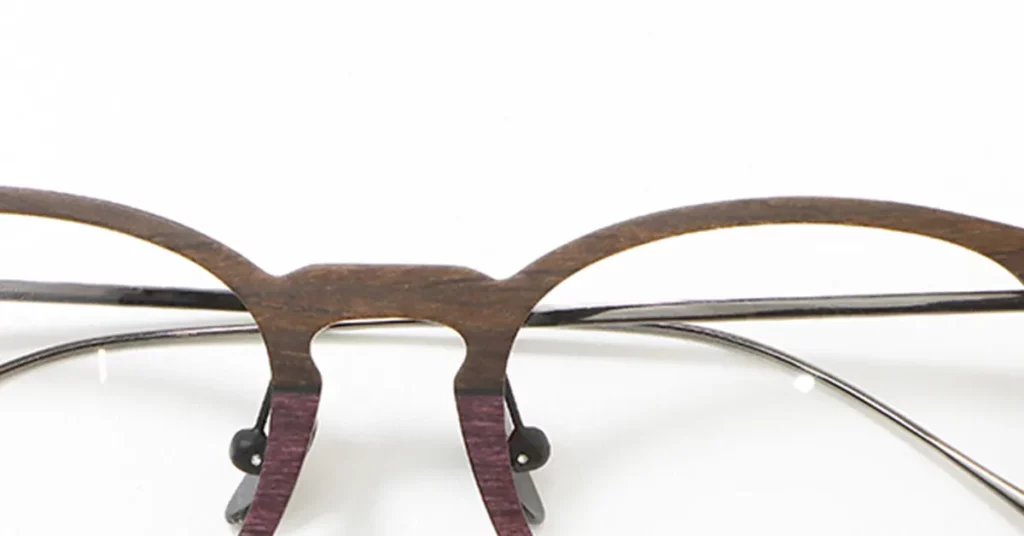
The Two Main Aesthetic Families
For eyewear, you’ll primarily encounter two distinct families of carbon fiber, each with a unique visual signature. Your choice between them is purely about the aesthetic story you want your product to tell.
Woven Carbon Fiber: The Classic Look
Woven carbon fiber is the traditional and most recognizable form. This is the material that features those clean, organized patterns. It communicates precision, structure, and classic performance.
Definition: The most common pattern is a 2×2 twill weave, which means each bundle of fibers passes over two perpendicular bundles and then under two. This simple sequence is what creates that iconic and desirable diagonal ribbing effect.
Forged Carbon Fiber: The Modern Look
Forged carbon fiber offers a completely different, more modern aesthetic. Instead of an organized weave, it uses chopped carbon fibers mixed with resin that are compressed at high pressure. This results in a random, marbled pattern that looks more organic and chaotic. No two frames with forged carbon are ever exactly alike.
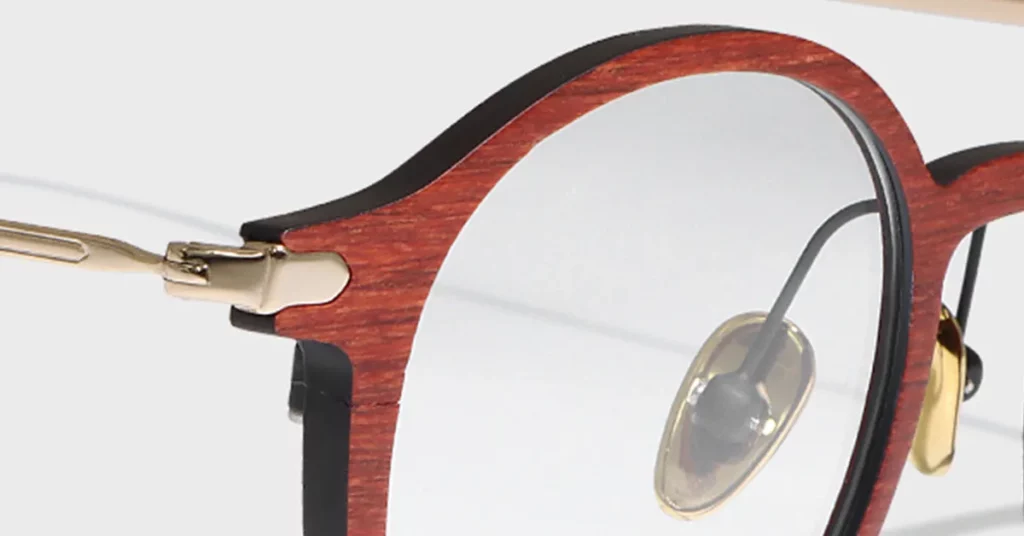
The Engineer’s Guide: 4 Methods for Coloring Carbon Fiber
While carbon fiber’s soul is black, several advanced manufacturing techniques allow you to introduce color. Remember This: The best methods integrate color without covering up the beautiful weave that makes the material special.
Method 1: Pigmenting the Resin
This technique involves mixing colored pigments directly into the epoxy resin before it’s applied to the raw carbon fiber fabric. This creates a translucent, candy-coat effect. The underlying black weave remains visible, but it’s viewed through a layer of vibrant color, like red or blue.
Method 2: Hybrid Weaves & Alternative Fibers
This is a more sophisticated approach where colored or metallic threads are woven directly alongside the black carbon fibers. This makes the color part of the material’s structure.
For Example: Weaving in Texalium, a fiberglass-based fabric coated in pure aluminum, creates a bright, reflective silver pattern against the black. For color, aramid fibers (like Kevlar) can be dyed yellow, red, or blue and woven in to create striking highlights.
Method 3: Surface Treatments & Coatings
This is the most straightforward but often least desirable method. It involves painting the finished carbon fiber part. While this gives you unlimited color options, it has a major drawback: it completely hides the underlying weave. This removes the very visual texture that makes carbon fiber unique and valuable.
Method 4: Metal Plating
For a truly luxurious finish, you can plate carbon fiber with precious metals. This involves chemically bonding a thin layer of metal, such as gold or palladium, onto the surface. This technique creates a stunning, high-end look while often allowing some of the carbon texture to show through, as seen in ultra-premium Bugatti Eyewear.
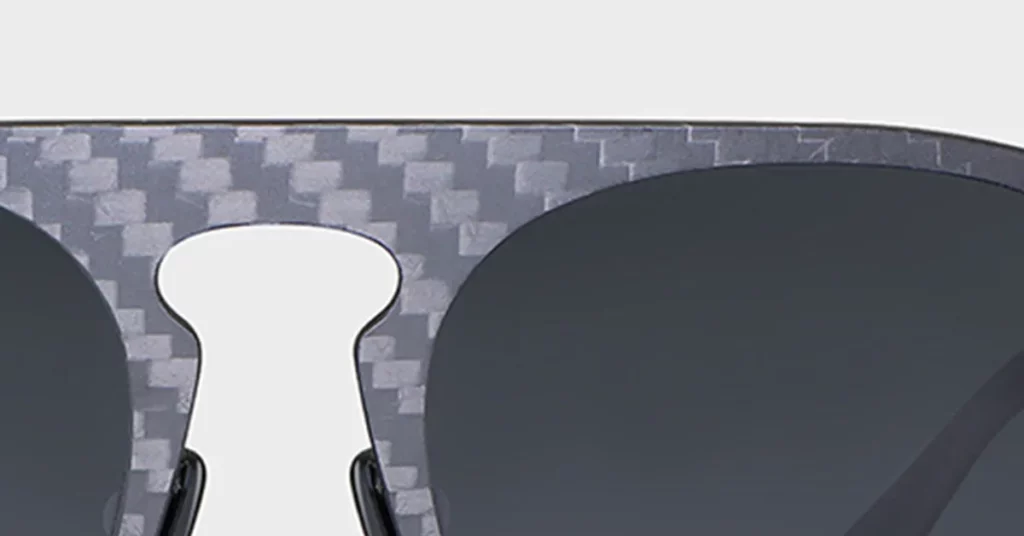
The Brand Manager’s Dilemma: Cost vs. Benefit
Is carbon fiber worth the high price tag for your brand? To answer that, you need to weigh its powerful benefits against its critical limitations.
The Business Case: Core Strengths (Pros)
- “Unfeelable” Comfort: Carbon fiber is exceptionally lightweight, making frames incredibly comfortable for all-day wear. This isn’t just a small difference; it’s a game-changer for the end user, eliminating pressure points on the nose and ears.Key Metric: With a density of just 1.6 g/cm³, carbon fiber is dramatically lighter than titanium (4.5 g/cm³) and steel (7.8 g/cm³). In fact, carbon fiber frames can be 29% lighter than titanium ones.
- “Built to Last” Durability: Despite its low weight, carbon fiber has a remarkable strength-to-weight ratio. It is five to ten times stronger than steel by weight, giving it fantastic durability for the rigors of daily use.
- “Worry-Free” Material: Carbon fiber is 100% hypoallergenic, making it a perfect choice for customers with sensitive skin who may react to certain metals. It’s also completely resistant to corrosion from sweat or moisture, so the frame’s integrity and appearance will last.
- “High-Tech” Brand Story: The material has powerful brand equity, built from its use in aerospace, Formula 1 racing, and military tech. Using carbon fiber instantly positions your eyewear as a premium, technologically advanced product.
The Strategic Risks: Critical Limitations (Cons)
- The Sticker Shock: Carbon fiber is one of the most expensive materials you can choose. The complex, labor-intensive manufacturing process and high cost of raw materials mean a significantly higher price compared to acetate or standard metals.
- The Rigidity Problem: Carbon fiber is extremely rigid and cannot be adjusted by an optician. Unlike a metal frame that can be heated and bent for a custom fit, a carbon fiber frame’s shape is permanent once it’s made.Critical Warning: You must never allow an optician to heat or bend a carbon fiber frame. It will not flex; it will snap. This is called catastrophic failure, and it will destroy the frame instantly.
- “Sudden Death” Brittleness: The material exhibits brittle failure. This means it doesn’t bend or warp under extreme stress to give you a warning; it simply cracks or shatters suddenly.Simple Analogy: Think of carbon fiber’s failure mode like glass. It’s incredibly strong up to its limit, but once that limit is passed, it breaks instead of bending.
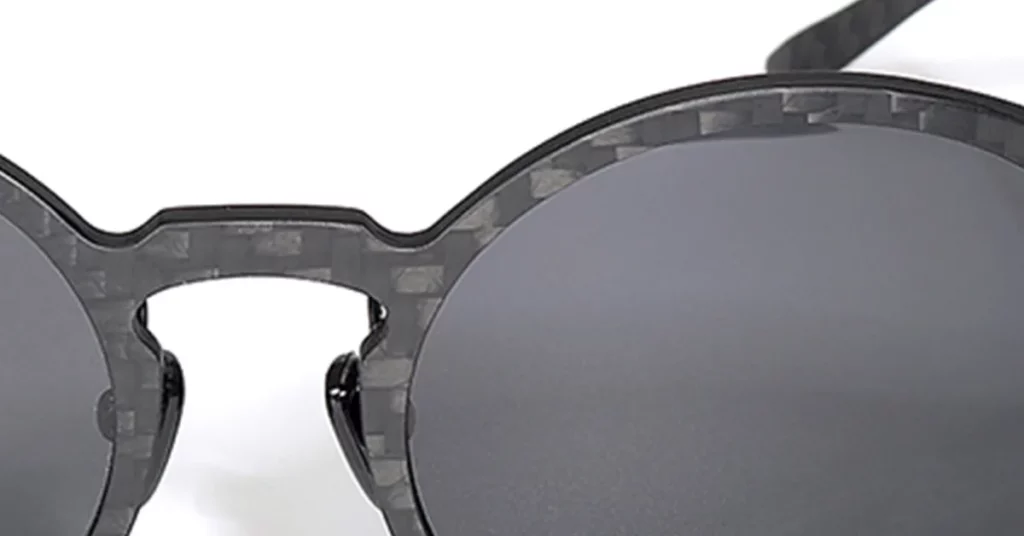
Decision Matrix: Carbon Fiber vs. Titanium
For many brands, the final decision for a premium frame comes down to carbon fiber versus titanium. Both are excellent materials, but they serve different needs. Use this table to make your choice clear.
| Feature | Carbon Fiber | Titanium |
| Weight & Comfort | Ultra-lightweight (up to 29% lighter) | Very lightweight, but heavier than CF |
| Adjustability & Fit | Cannot be adjusted; fit is permanent | Highly adjustable for a custom fit |
| Durability | Extremely strong, but can crack suddenly | Very strong, but tends to bend, not break |
| Cost | Very Expensive | Expensive, but generally less than CF |
| Aesthetic | High-tech, racing-inspired, textured | Clean, minimalist, professional |
The Bottom Line: Choose carbon fiber when your top priorities are the absolute lightest weight possible and a bold, high-tech aesthetic for a customer who values performance above all. Choose titanium when adjustability for a perfect, customized fit is a must-have, and you prefer a clean, minimalist look.
Beyond Black: A Designer’s Gallery of Hybrids
One of the best ways to use carbon fiber is in combination with other materials. This allows you to get the best of both worlds—marrying its lightweight strength with the aesthetic possibilities of other materials.
Combination 1: Carbon Fiber Temples + Acetate Front
This is a classic hybrid strategy. It combines the lightweight, high-tech feel of carbon fiber on the temples (the arms) with the infinite color and pattern possibilities of an acetate frame front. You get performance where it counts and creative freedom where it shows most.
Combination 2: Carbon Fiber Temples + Metal Front
Pairing carbon fiber temples with a steel or titanium front creates a sleek, industrial, and highly engineered look. This combination screams precision and technical sophistication, perfect for a brand that targets customers who appreciate fine engineering and a modern aesthetic.
Combination 3: Carbon Fiber + Wood
This unexpected pairing creates a powerful visual story. It fuses a natural, organic texture from wood with the technical, man-made pattern of carbon fiber. This creates a beautiful contrast that appeals to customers who value both nature and technology.
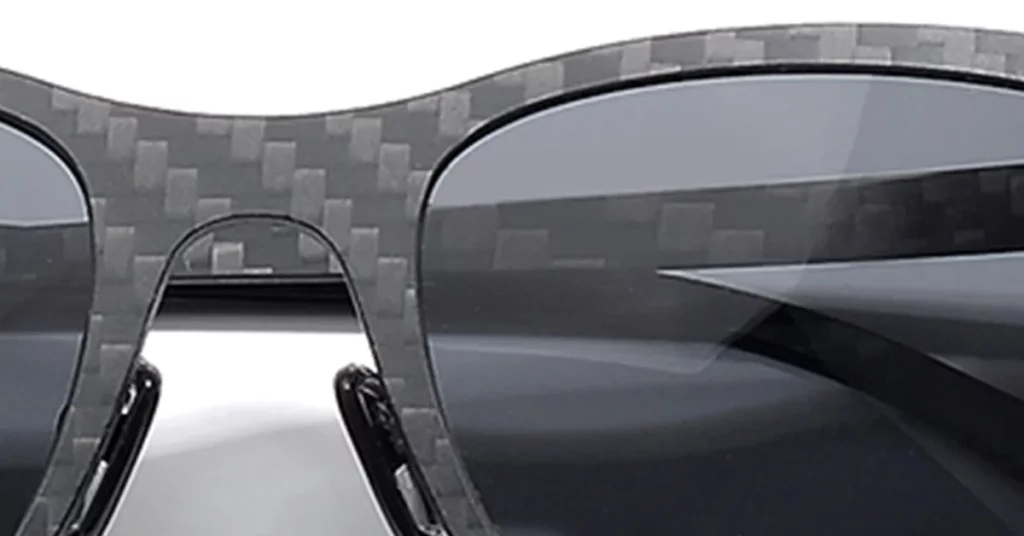
Conclusion
Carbon fiber is naturally black, but your design palette is far from limited. By understanding how to use resin tints, hybrid weaves, and unique finishes, you can create stunning visual effects. While it offers unmatched lightweight comfort and a powerful high-tech story, you must weigh this against its higher cost and total lack of adjustability. Ultimately, choosing carbon fiber is a strategic decision that depends entirely on your brand’s identity and your customer’s priorities.
Frequently Asked Questions
1. Can an optician adjust my carbon fiber glasses?
No, carbon fiber frames cannot be heated or bent for adjustments. The fit you get at purchase is permanent. Any adjustability must come from components like flexible temple tips or adjustable nose pads designed into the frame.
2. Is forged carbon fiber better than woven?
Neither is “better” for eyewear; the choice is purely aesthetic. Woven carbon has the classic, diagonal pattern associated with performance. Forged carbon has a modern, marbled look where every single frame is unique.
3. Do colored carbon fiber frames scratch easily?
It depends on how the color was applied. If it’s a surface paint, it can scratch. But if the color is integrated into the resin or woven in with fibers like Texalium, the color is part of the material itself and is highly scratch-resistant.
4. How can I tell if a frame is real carbon fiber?
Look for a deep, three-dimensional texture in the weave that seems to shift in the light. Real carbon fiber is also exceptionally lightweight. Fakes are often just heavier plastic with a flat, printed-on pattern that lacks any depth.
5. Is carbon fiber worth the cost for everyday glasses?
It is if your highest priority is achieving the lightest possible weight in a frame with a luxury, high-tech look. If you know you’ll need fit adjustments or prefer a more classic, understated style, titanium is often a more practical premium choice.


